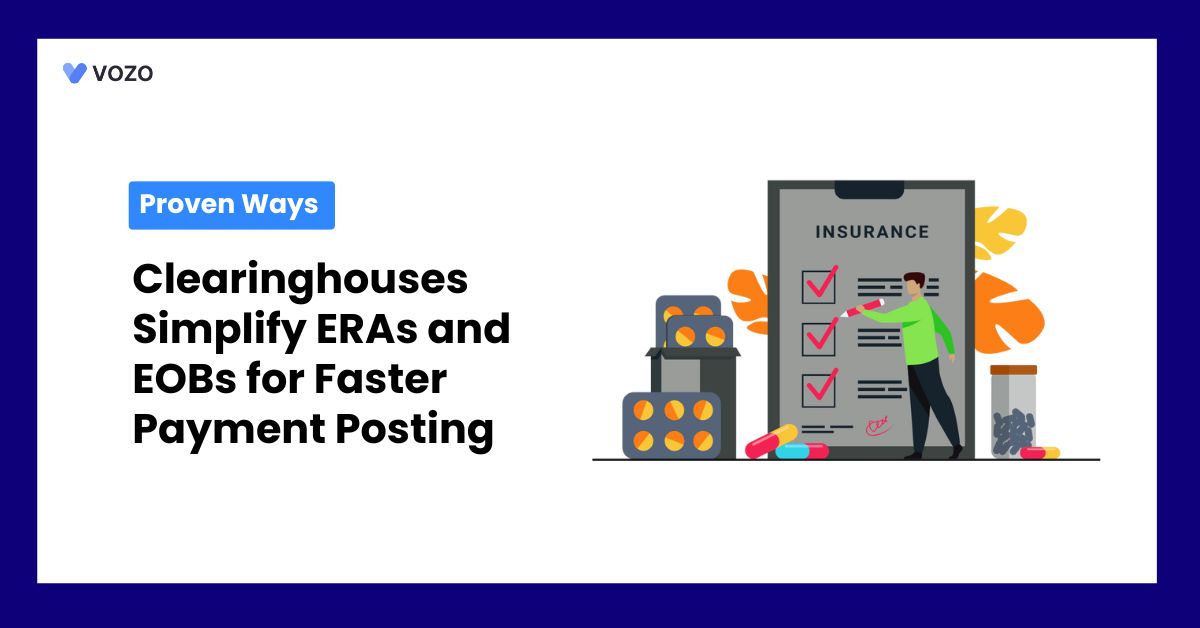Proven Ways Clearinghouses Simplify ERAs and EOBs for Faster Payment Posting
In healthcare, timely payments are critical. However, complicated processes can slow payment. Clearinghouses address these issues by streamlining Electronic Remittance Advice and Explanation of Benefits for speedier payment posting. They serve as efficient mediators, turning complex billing data into well-organized digital records.
This automated procedure lowers errors and the need for manual data entry, allowing healthcare providers to get compensation more quickly. Clearinghouses increase cash flow and administrative efficiency by simplifying financial data.
In this blog, we discussed how clearinghouses promote simpler payment processing, resulting in better financial management in healthcare, increased efficiency, and long-term growth.
The Importance of Payment Posting in Healthcare Revenue Cycle
Payment posting is the step where healthcare providers record every payment they receive, whether from insurance companies or patients, into their billing system.
Here’s why this simple task is so important in healthcare’s revenue cycle:
- By entering each payment correctly, providers have an up-to-date picture of how much money they’ve received and how much they’re still owed. This helps prevent mistakes that might lead to missing revenue.
- When payments are posted promptly, healthcare providers can more reliably cover their operating costs.
- Recording payments accurately makes it easier to spot errors, such as when an insurer underpays a claim or when a claim is denied.
- Proper payment posting ensures that patient accounts are accurate. This means that when patients receive their bills, they see the correct charges and know exactly what they owe.
- Healthcare is a highly regulated field. Accurate records of payments help providers comply with guidelines from government agencies and insurance companies. So that the providers will reduce the risk of fines or other penalties.
Related: Why Is Accurate Payment Posting Important In RCM?
7 Ways Clearinghouse Simplifies ERAs and EOBs
1. Automating Data Collection and Standardization
- Clearinghouses electronically gather ERAs and EOBs from different insurance companies and eliminate the need for manual retrieval.
- They convert these documents into a consistent format, regardless of the source. This uniformity makes it easier for healthcare providers to process and understand the information.
- By standardizing data, clearinghouses help reduce discrepancies and errors that can occur when handling diverse document formats.
- The standardized data can be seamlessly integrated into a provider’s billing or electronic health record systems.
2. Seamless Integration with EHR and Practice Management Systems
- Once a patient visit is documented in your EHR, the system can automatically generate and send insurance claims through the clearinghouse.
- The clearinghouse reviews claims for common mistakes before they reach the insurer, increasing the likelihood of approval and faster payments.
- When insurers process claims, they send back ERAs or EOBs.
- The integrated system automatically matches these with the corresponding patient records, updating payment statuses without manual intervention.
- Before appointments, the system can check a patient’s insurance coverage in real-time.
Related: How RCM Integrated EHR Solution Can Help to Improve Your Practice Revenue
3. Intelligent Claim Matching and Reconciliation
- The clearinghouse receives ERAs from insurance companies and uses advanced algorithms to match each payment to the corresponding claim in the provider’s system.
- Once matched, the system reconciles the payment information, updating the provider’s records to reflect the payment status.
- This process includes noting any adjustments, denials, or patient responsibilities.
- By automating this process, the likelihood of human errors, such as misapplied payments or overlooked denials, is significantly reduced.
4. Centralized Dashboard and Reporting Tools
- Instead of navigating through multiple systems or paper documents, you can access all ERA and EOB information through a single, user-friendly interface.
- Dashboards provide up-to-date information on claim statuses, payments received, and outstanding balances.
- Reporting tools can automatically generate summaries and detailed reports. This highlights trends such as common denial reasons or payment delays.
- By centralizing data, these tools reduce the risk of errors associated with manual data entry and fragmented information sources.
5. Faster Identification of Denials and Underpayments
- Clearinghouse automates the EOBs and ERAs by notifying providers immediately when a claim is denied or underpaid, allowing for prompt action.
- Providing standardized codes that explain why a claim was denied or adjusted. This makes it easier for quicker understanding and resolution.
- Routing problematic claims to the appropriate staff members for correction and resubmission.
6. Enhancing Compliance and Documentation
- Clearinghouses convert various data formats into standardized electronic formats, such as the ANSI X12 835 for ERAs. This standardization ensures consistency and compliance with federal regulations.
- By transmitting data electronically, clearinghouses reduce the reliance on paper documents. This minimizes the risk of lost or mishandled information.
- They implement robust security measures to protect sensitive patient data during transmission.
- Clearinghouses automatically log all transactions, creating an audit trail that can be invaluable during compliance checks or audits.
- They provide timely updates on claim statuses, allowing providers to address issues promptly and maintain accurate records.
7. Supporting Secondary and Tertiary Billing
- After the primary insurer processes a claim and issues an Electronic Remittance Advice, the clearinghouse uses this information to automatically prepare and submit claims to the secondary insurer, and subsequently to the tertiary insurer if applicable.
- By validating and formatting claims according to each insurer’s requirements, the clearinghouse minimizes errors that could lead to claim denials or delays.
- The clearinghouse ensures that payment information from the primary insurer is accurately applied when billing secondary and tertiary insurers. This facilitates proper coordination among all parties.
- Providers can monitor the status of all claims, primary, secondary, and tertiary, through a unified dashboard. This enhances transparency and control over the billing process.
Vozo Revenue Management Cycle Service
At Vozo, we understand your struggle in navigating through all the revenue cycle processes such as regulations, medical coding, and reimbursements.
That’s why we bring the best cutting-edge service to optimize your revenue cycle management from start to finish. Here’s how Vozo can help you transform your practice’s financial performance.
- Automated tools for error-free coding and faster reimbursements
- User-friendly billing to keep patients satisfied and payments flowing
- Robust data security and compliance protocols to protect your practice
- Detailed reporting and analytics for smarter business decisions
- Solutions that grow alongside your evolving needs
With Vozo RCM service, you can reduce the headaches associated with revenue cycle management and focus on what matters the most – quality patient healthcare delivery.
“Partner with Vozo RCM Service and unlock the full potential of your healthcare practice and maximize its revenue”.
About the author

With more than 4 years of experience in the dynamic healthcare technology landscape, Sid specializes in crafting compelling content on topics including EHR/EMR, patient portals, healthcare automation, remote patient monitoring, and health information exchange. His expertise lies in translating cutting-edge innovations and intricate topics into engaging narratives that resonate with diverse audiences.













